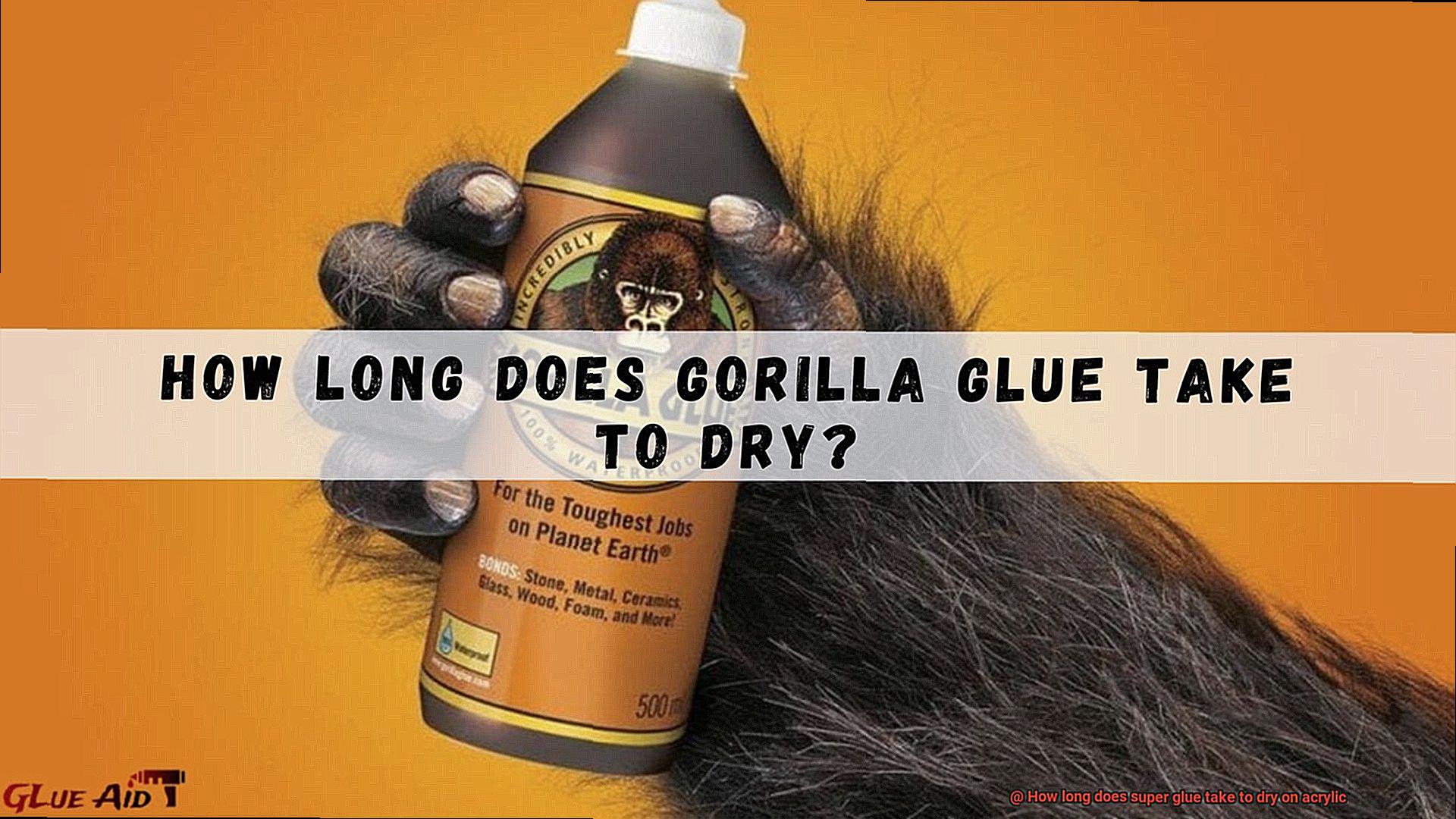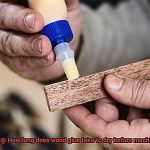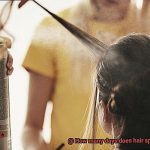Picture this: you’ve got a broken acrylic masterpiece, or maybe you’re itching to create something mind-blowing with your DIY skills. Either way, you reach for that trusty tube of super glue, ready to bond those surfaces together in record time. But hey, have you ever wondered just how long it takes for that magical adhesive to dry on acrylic? Well, my friend, get ready for a journey into the fascinating world of super glue drying time on acrylic.
In this blog post, we’re diving deep into the secrets behind this sticky phenomenon. We’ll unravel the mysteries of what affects drying time, spill the beans on techniques to speed up or optimize the process, and arm you with expert tips so your bonding experience is nothing short of brilliant. So grab your safety goggles and join us as we unveil the art of patience when it comes to super glue drying time on acrylic. Trust me, it’s gonna be epic.
What is Super Glue?
Contents
- 1 What is Super Glue?
- 2 Factors Affecting Drying Time of Super Glue on Acrylic
- 3 General Drying Time of Super Glue on Acrylic
- 4 Curing Time of Super Glue on Acrylic
- 5 Environmental Factors Impacting the Drying and Curing Time
- 6 Tips for Speeding Up the Drying and Curing Process
- 7 Precautions to Take When Using Accelerators
- 8 Conclusion
In the world of adhesives, one product reigns supreme for its unmatched strength and rapid bonding ability – Super Glue. In this comprehensive article, we will delve into the captivating world of this extraordinary adhesive, exploring its properties and uncovering its countless applications.
Discovering the Accidental Wonder:
Originally seeking a clear plastic for war-related purposes, Dr. Harry Coover stumbled upon the exceptional qualities of cyanoacrylate adhesive in 194This serendipitous discovery led to the accidental creation of Super Glue, a remarkable adhesive that would revolutionize the industry.
The Science Behind the Magic:
Super Glue achieves its phenomenal bonding power through a process called polymerization. When exposed to moisture, it undergoes a chemical reaction that rapidly links the molecules together, forming robust polymer chains. Within seconds, an instant and durable bond is formed between surfaces.
Versatile Strength:
One of Super Glue’s greatest advantages lies in its versatility. It effortlessly bonds an array of materials, including acrylic, metal, plastic, rubber, and certain types of wood. Whether it’s repairing household items or tackling demanding industrial projects, Super Glue has cemented its status as the adhesive of choice.
Viscosity Matters:
Super Glue is available in various viscosities to cater to different needs. Thin Super Glue effortlessly seeps into tight gaps and crevices, making it perfect for intricate repairs. Gel Super Glue stays put without dripping or running, providing optimal control and precision in vertical applications.
Handle with Care:
While Super Glue boasts immense power, it should be handled with caution. Its strong bonding properties can inadvertently cause unintentional adhesion to skin or other surfaces if mishandled. Wearing gloves and working in well-ventilated areas are highly recommended safety measures.
Factors Affecting Drying Time of Super Glue on Acrylic
In this blog post, we will delve into the factors that influence the drying time of Super Glue on acrylic surfaces. From temperature and humidity to surface preparation and ventilation, we will uncover the secrets behind achieving optimal drying times for your adhesive projects.
Temperature:
Imagine temperature as the accelerator pedal for Super Glue’s drying time. Higher temperatures rev up the chemical reactions involved in the curing process, resulting in faster drying. Conversely, lower temperatures put the brakes on these reactions. So, if you’re in a hurry to complete your project, consider working in a warmer environment to expedite the drying process.
Humidity:
Humidity levels can either be a friend or foe when it comes to drying time. High humidity can prolong the drying process by competing with the solvents in the glue for evaporation. On the other hand, low humidity acts as a facilitator for quicker drying as there is less moisture present to impede evaporation. Keep a watchful eye on your local weather conditions to achieve optimal drying times.
Thickness of Glue Application:
The thickness of the Super Glue layer plays a pivotal role in drying time. Thicker layers take longer to dry as there is more material that needs to evaporate. To ensure faster drying, apply a thin and uniform layer of Super Glue on your acrylic surface.
Type and Quality of Super Glue:
Not all Super Glues are created equal. Different brands and types possess distinct compositions and formulas, resulting in varying drying times on acrylic surfaces. It is crucial to select a high-quality Super Glue specifically designed for bonding acrylic materials. These glues are formulated for optimal adhesion and swift curing.
Surface Preparation:
Properly preparing your acrylic surface before applying Super Glue can significantly impact drying time. Ensure that the surface is spotless and free from any dirt, oil, or residue, as these can hinder adhesion and extend drying time. Thoroughly clean the surface with a mild detergent and ensure it is completely dry before applying Super Glue.
Ventilation:
Good airflow is the unsung hero of quick drying times. Adequate ventilation in your workspace helps carry away evaporating solvents, promoting faster curing. Consider working in a well-ventilated space or using a fan to enhance air circulation around the glued area.
General Drying Time of Super Glue on Acrylic
The drying time of super glue on acrylic surfaces can vary depending on several factors. First and foremost, it is important to consider the type and brand of super glue being used. Different formulations may have different drying times, with some brands offering quick-drying options that can set in seconds, while others may take a few minutes.
The thickness of the glue application also plays a crucial role in the drying time. Applying a thin and even layer of super glue promotes faster drying. On the other hand, using excessive amounts or applying it too thickly can prolong the drying time.
Environmental conditions, such as humidity levels and temperature, can significantly affect how quickly super glue dries on acrylic surfaces. Higher humidity levels tend to slow down the drying process, while lower humidity levels accelerate it. If you’re working in a humid environment, it may be worth investing in a dehumidifier or finding ways to reduce moisture in the air.
Similarly, higher temperatures speed up the drying process, while colder temperatures can slow it down. If you’re eager to speed up the drying time, consider using a hairdryer on low heat or placing your project near a warm source.
While super glue may dry quickly to form a hardened surface within seconds, it’s important to exercise patience. To ensure a strong and durable bond, it’s recommended to wait at least 24 hours before subjecting the glued acrylic to any stress or load. This allows the glue to fully cure and reach its maximum strength.
Proper surface preparation is key to achieving optimal results. Make sure the acrylic surface is clean and free from any dust, dirt, or oils that could interfere with the adhesive’s ability to bond effectively. Wiping the surface with a mild solvent or alcohol before applying the super glue can help remove any contaminants.
Lastly, proper ventilation is essential during the drying process. Ensure you’re working in a well-ventilated area to prevent the build-up of fumes, which can be irritating to the eyes and respiratory system.
Curing Time of Super Glue on Acrylic
In this article, we will explore the intricate dance between these two materials and uncover the secrets behind their curing time. Get ready to dive into a fascinating journey that will equip you with all the knowledge you need to achieve flawless bonds. Let’s begin.
Factors Affecting Curing Time:
Type and Brand of Super Glue:
Just like dancers with distinct styles, different brands and types of super glue exhibit varying curing times. Some may dry within seconds, while others require a few minutes to showcase their adhesive prowess. It is crucial to choose a glue that aligns with your project’s needs, considering both the desired bonding time and strength.
Thickness of the Adhesive Layer:
The thickness of the adhesive layer also plays a vital role in the curing time of super glue on acrylic. Thin layers tend to dry faster, ensuring a swift bond. However, excessive application of glue can extend the performance duration, delaying the completion of the curing process. Remember, when it comes to gluing acrylic, less is more.
Environmental Conditions:
The stage for this intricate dance is set by environmental conditions. Factors such as humidity levels and temperature significantly influence the curing time of super glue on acrylic. Higher humidity and warmer temperatures accelerate the drying process, granting you an express ticket to a quick bond. Conversely, colder temperatures and low humidity slow down the curing process. Before embarking on your gluing adventure, be sure to check the weather forecast to optimize your results.
The Dance Continues: Full Curing Time:
While initial drying time refers to when the glue forms a skin or becomes tacky to the touch, achieving maximum bond strength and durability requires patience.
Even though the glue may appear dry on the surface, it needs time to complete its chemical reactions and reach its full potential.

It is recommended to allow at least 24 hours for the super glue to fully cure before subjecting your masterpiece to any stress or load.
Additional Tips and Tricks:
Surface Preparation:
To ensure a flawless performance, prepare your acrylic surface like a professional dancer. Cleanliness is key – remove any dust, oils, or contaminants that could disrupt the bond and spoil the show. Proper surface preparation ensures optimal adhesion and enhances the curing process.
Accelerators and Activators:
For those seeking an expedited bonding experience, some super glues offer accelerators or activators. These magical potions, applied either before or after gluing, can speed up the curing process, providing you with an instant bond. Talk about a time-saving hack.
Environmental Factors Impacting the Drying and Curing Time
Today, we’re delving into the captivating realm of environmental factors that influence the drying and curing time of super glue on acrylic surfaces. So, grab your magnifying glass and let’s take a closer look.
Temperature – The Hot and Cold Reality:
Temperature, the silent orchestrator of glue’s fate. Super glue adores warmth, as higher temperatures accelerate the chemical reaction that hardens the adhesive. For optimal drying and curing results, work in a cozy room with temperatures between 70°F and 90°F (21°C to 32°C). On the flip side, colder temperatures can leave our adhesive friend feeling sluggish, so keep it warm for a speedy bond.
Humidity – The Moisture Dilemma:
Enter humidity, the mischievous moisture monster. High humidity levels slow down drying by interfering with proper adhesive curing. Combat this culprit by working in an environment with a humidity level between 40% and 60%. Finding that delicate balance ensures your super glue doesn’t get caught in a sticky situation.
Porosity – The Sponge Effect:
Just like Goldilocks searching for perfect porridge, super glue craves surfaces with the right porosity. More porous acrylic surfaces offer opportunities for the adhesive to penetrate, leading to faster drying and curing times. Non-porous or smooth surfaces make our glue friend work harder, extending the process. Porosity can be your secret weapon when bonding acrylic.
Air Circulation – The Breath of Life:
Imagine a room with stale air and no ventilation – that’s like taking away glue’s oxygen. Adequate air circulation is essential for faster drying. By allowing fresh air to circulate around the glued area, excess moisture escapes, expediting the process. Bring in fans or work in a well-ventilated area to give your super glue the breath of life it needs.
Application Thickness – Thin is In:
The golden rule here is: the thinner, the better. Thicker layers take longer to dry and cure, as they require more time for the adhesive to penetrate and harden. For a speedy bonding experience, apply super glue in thin layers.
Tips for Speeding Up the Drying and Curing Process
Super glue is a popular adhesive for bonding acrylic surfaces due to its quick-drying properties. However, there are times when we need the glue to dry even faster. In this article, we will explore five effective tips and techniques to speed up the drying and curing process of super glue on acrylic surfaces.
Apply a Thin Layer of Glue:
To speed up the drying process, apply a thin and even layer of super glue on the surfaces to be bonded. Excessive amounts of glue can slow down drying as it takes longer for the excess to evaporate. Using a thin layer allows for quicker evaporation, resulting in faster drying.
Use Heat:
Gently applying heat to the glued area can accelerate the evaporation of the solvent in the glue, thereby speeding up drying. Use a hairdryer set to a low or medium heat setting and blow hot air onto the glue. Be careful not to overheat the acrylic, as excessive heat can cause damage.
Increase Airflow:
Promote faster drying by increasing airflow around the glued area. Use a fan or open windows and doors to improve ventilation. Moving air helps carry away moisture, expediting the drying process. This technique is especially useful for larger or thicker applications of super glue.
Utilize Accelerators or Activators:
Consider using accelerators or activators specifically designed for super glue. These products react with the glue’s composition, expediting the bond formation between acrylic and glue. Follow manufacturer instructions when using accelerators or activators.
Allow Sufficient Curing Time:
While these tips can speed up drying, it is crucial to allow sufficient time for the glue to fully cure. Even if the surface appears dry, the inner layers may still be curing. Wait at least 24 hours before subjecting the glued acrylic to any stress or load.
Precautions to Take When Using Accelerators
When it comes to working with super glue and accelerators on acrylic surfaces, prioritizing safety is essential for achieving the best results. In this blog post, we’ll discuss the precautions you should consider when using accelerators with super glue on acrylic. So, let’s explore these safety measures.
Work in a well-ventilated area:
To protect yourself from the potentially harmful fumes that super glue accelerators can release, it’s crucial to work in a well-ventilated space. Boost air circulation by opening windows, using fans, or employing exhaust systems. Additionally, wearing a mask or respirator designed to filter chemical fumes adds an extra layer of defense.
Protect your skin:
Super glue accelerators can be harsh on the skin and may cause irritation or chemical burns upon direct contact. Safeguard your hands by always wearing gloves while working with accelerators. In the event of skin contact, immediately rinse the affected area with water and seek medical attention if necessary.
Read and follow instructions:
Different super glue and accelerator products have varying application techniques, drying times, and potential hazards. To ensure the best outcome and minimize risks associated with incorrect usage, carefully read and follow the instructions provided by the manufacturer for both products.
Use accelerators sparingly:
Although accelerators speed up the drying process of super glue, excessive use can make the glue brittle and weaken its bond strength. Apply accelerators sparingly and only when necessary. It is advisable to test the compatibility of the super glue and accelerator on a small area of the acrylic before proceeding with larger projects.
Proper storage:
To maintain effectiveness and prevent accidents, store super glue and accelerators in cool, dry places away from direct sunlight and heat sources. Keep them out of reach of children and pets to avoid any potential harm.
Aonikb1CPOU” >
Conclusion
In conclusion, the drying time of super glue on acrylic surfaces can vary due to several factors. The type and brand of super glue, the thickness of the application, environmental conditions like temperature and humidity, surface preparation, and ventilation all play a role in determining how quickly the glue dries.
To ensure a strong bond on acrylic materials, it is crucial to select a high-quality super glue that is specifically designed for this purpose. Applying a thin and even layer of glue will expedite the drying process, as thinner layers dry faster than thicker ones. Higher temperatures and lower humidity levels act as catalysts for quicker drying, while colder temperatures and higher humidity levels slow it down.
Although super glue may give the impression of being dry on the surface within seconds, it is advisable to wait at least 24 hours for it to fully cure before subjecting the bonded acrylic to any stress or load. Enhancing adhesion and speeding up drying time can be achieved through proper surface preparation: thoroughly cleaning the surface and ensuring it is free from dirt or oils.
If you’re looking to speed up the drying process even further, there are some additional tips you can follow. Utilizing heat sources like hairdryers or increasing airflow with fans or open windows can expedite drying. There are also accelerators or activators specifically designed for super glue that can be used to quicken the process. However, it is important to allow sufficient curing time after using these accelerators.
When working with accelerators on acrylic surfaces, take precautions to ensure safety. Always work in a well-ventilated area, protect your skin by wearing gloves, carefully read and follow instructions provided by the manufacturer, use accelerators sparingly, and store them properly.
By understanding these factors and following these tips and precautions, you can confidently harness the power of super glue on acrylic surfaces.






